Megapress G
Product information
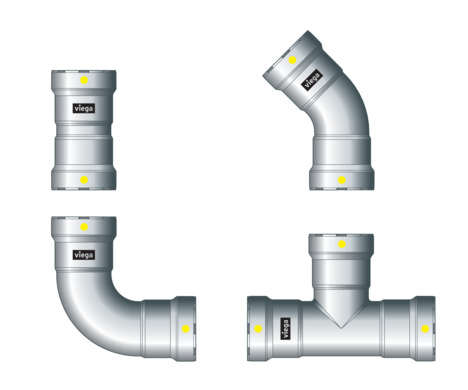
Megapress G
Press connector system made of non-alloy steel for thick-walled steel pipes
| Year built (from): | 01/03/2016 |
Trade mark rights exist for this document; for further information, go to viega.com/legal .
Target groups
The information in this instruction manual is directed at the following groups of people:
Contract installers
Professional companies specialising in the construction, maintenance and alteration of a natural or liquid gas system
Liquid gas systems may only be constructed, maintained or altered by companies that have the necessary qualification and experience.
Individuals without the abovementioned training or qualification are not permitted to mount, install and, if required, maintain this product. This restriction does not extend to possible operating instructions.
The installation of Viega products must take place in accordance with the general rules of engineering and the Viega instructions for use.
Labelling of notes
Warning and advisory texts are set aside from the remainder of the text and are labelled with the relevant pictographs.
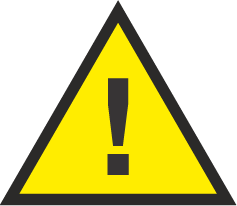
DANGER!
This symbol warns of possible life-threatening injury.
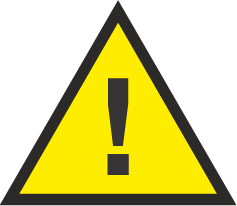
WARNING!
This symbol warns of possible serious injury.
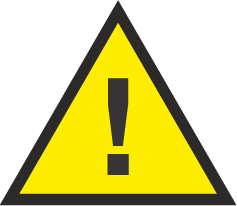
CAUTION!
This symbol warns of possible injury.

NOTICE!
This symbol warns of possible damage to property.
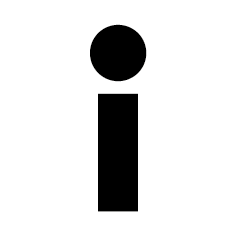
INFO!
This symbol gives additional information and hints.
About this translated version
This instruction for use contains important information about the choice of product or system, assembly and commissioning as well as intended use and, if required, maintenance measures. The information about the products, their properties and application technology are based on the current standards in Europe (e.g. EN) and/or in Germany (e.g. DIN/DVGW).
Some passages in the text may refer to technical codes in Europe/Germany. These should serve as recommendations in the absence of corresponding national regulations. The relevant national laws, standards, regulations, directives and other technical provisions take priority over the German/European directives specified in this manual: The information herein is not binding for other countries and regions; as said above, they should be understood as a recommendation.
Standards and regulations
The following standards and regulations apply to Germany / Europe and are provided as a support feature.
Regulations from section: Application areas
Scope / Notice | Regulations applicable in Germany |
|---|---|
Planning, execution, modification and operation of gas installations | DVGW-TRGI 2018 |
Gas installations for industrial, commercial and process plants | DVGW-Arbeitsblatt G 5614-B1 |
Gas installations for industrial, commercial and process plants | DVGW-Arbeitsblatt G 462 |
Gas installations for industrial, commercial and process plants | DVGW-Arbeitsblatt G 459‑1 |
Gas installations for industrial, commercial and process plants | DVGW-Fachinformation Nr. 10 |
Planning, execution, modification and operation of liquid gas installations | DVFG-TRF 2021 |
Regulations from section: Media
Scope / Notice | Regulations applicable in Germany |
|---|---|
Suitability for gases Liquid gas in the gaseous state | DVGW-Arbeitsblatt G 260 |
Suitability for fuel oil | DIN 51603‑1 |
Suitability for diesel fuel | DIN EN 590 |
Regulations from section: Pipes
Scope / Notice | Regulations applicable in Germany |
|---|---|
Differentiation of pipe types and pipe series | DIN EN 10255 |
Requirements in steel pipes - Boiler pipe quality | DIN EN 10220 |
Requirements in steel pipes - Boiler pipe quality | DIN EN 10216–1 |
Requirements in steel pipes - Boiler pipe quality | DIN EN 10217–1 |
External protective coatings (galvanisation) for steel pipes | DIN EN 10240 |
Rules of the fixing technology for gas installations | DVGW-TRGI 2018, Point 5.3.7 |
Rules of the fixing technology for gas installations | DVFG-TRF 2021, Point 7.3.6 |
Regulations from section: Corrosion
Scope / Notice | Regulations applicable in Germany |
|---|---|
(Subsequent) corrosion protection for underground installation | DIN 30672 |
Corrosion protection for external pipes | DVGW-TRGI 2018, Point 5.2.7.1 |
Corrosion protection for internal pipelines | DVGW-TRGI 2018, Point 5.2.7.2 |
Corrosion protection for external pipes | DVFG-TRF 2021, Point 7.2.7.1 |
Corrosion protection for internal pipelines | DVFG-TRF 2021, Point 7.2.7.2 |
Regulations from section: Storage
Scope / Notice | Regulations applicable in Germany |
|---|---|
Requirements for material storage | DIN EN 806‑4, Chapter 4.2 |
Regulations from section: Notes on mounting
Scope / Notice | Regulations applicable in Germany |
|---|---|
The general rules of mounting for gas installations | DVGW-TRGI 2018, Point 5.3.7 |
The general rules of mounting for gas installations | DVFG-TRF 2021, Point 7.3.6 |
Regulations from section: Establishing a flange connection
Scope / Notice | Regulations applicable in Germany |
|---|---|
Qualification of personnel for the assembly of flange connections | VDI-Richtlinie 2290 |
Regulations from section: Leakage test
Scope / Notice | Regulations applicable in Germany |
|---|---|
Leakage test for gas installations | DVGW-TRGI 2018, Point 5.6 |
Testing and initial commissioning of a liquid gas system | DVFG-TRF 2021, Point 8 |
Regulations from section: Maintenance
Scope / Notice | Regulations applicable in Germany |
|---|---|
Ensuring and maintaining a safe operating condition of gas installations | DVGW-TRGI 2018, Appendix 5c |
Intended use

INFO!
Agree the use of the system for areas of application and media other than those described with Viega.
Areas of application
The system is intended for use in gas installations and is a replacement for weld, threaded and roller-groove connections during new installations and repairs.
Use is possible in the following areas among others:
Gas installations, see Regulations from section: Application areas
Liquid gas installations, also see Regulations from section: Application areas .
Heating oil pipelines
Diesel pipes
Compressed air systems
Systems for technical gases (on request)
Gas installation
For planning, execution, modification and operation of gas installations, observe the applicable regulations, see Regulations from section: Application areas .
Use is possible in the gas installations described below:
Gas installations
Low pressure range ≤ 100 hPa (100 mbar)
Medium pressure range from 100 hPa (100 mbar) to 0.5 MPa (5 bar)
Industrial, commercial and technical processing systems with the corresponding directives and technical regulations up to 0.5 MPa (5 bar)
Liquid gas installations
With liquid gas tank in medium pressure range downstream of the pressure regulating valve, 1st level on the liquid gas tank > 100 hPa (100 mbar) up to a permitted operating pressure of 0.5 MPa (5 bar)
With liquid gas tank in the low pressure range ≤ 100 hPa (100 mbar) behind the pressure regulating valve, 2nd level
With liquid gas pressurised container (liquid gas bottles) < 16 kg
Behind the small bottle pressure regulating valve
With liquid gas tank (liquid gas bottle) ≥ 16 kg
Behind the large bottle pressure regulating device
Media
The system is suitable for the following media, amongst others:
For the applicable directives, see Regulations from section: Media .
Gases
Liquid gases, only in the gaseous state for domestic and commercial applications
Heating oil
Diesel fuel
Compressed air (dry)
Product description
Overview
The piping system consists of press connectors for thick-walled steel pipes and the corresponding press tools.
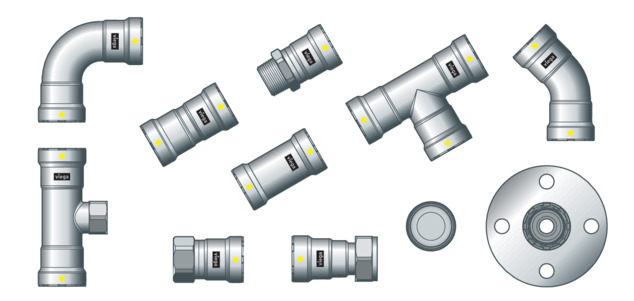
The system components are available in the following dimensions: D½ (DN 15), D¾ (DN 20), D1 (DN 25), D1¼ (DN 32), D1½ (DN 40), D2 (DN 50).
Pipes
Megapress G press connectors may be used with the following seamless (S) or longitudinal welded (W) steel pipes:
Black
Galvanised
The steel pipes and galvanisation must correspond to the applicable regulations, see Regulations from section: Pipes

INFO!
If there is galvanisation on the pipe, the maximum external diameters indicated in the tables must not be exceeded.
Pipe overview – threaded pipe quality
The standard differentiates between heavy pipe series H and medium pipe series M or between pipe type L, L 1 and L 2. Seamless pipes and pipes welded along the longitudinal seam belong to the different pipe series and pipe types, see Regulations from section: Pipes .
Only medium pipe series M and the heavy pipe series H may be used with Megapress G components.
Threaded pipe quality – heavy series H and medium series M
Thread size [inch] | Nominal width [DN] | Nominal external diameter [mm] | Min. external diameter incl. coating [mm] | Max. external diameter incl. coating [mm] | Wall thickness heavy series H [mm] | Wall thickness medium series M [mm] |
|---|---|---|---|---|---|---|
½ | 15 | 21.3 | 21.0 | 21.8 | 3.2 | 2.6 |
¾ | 20 | 26.9 | 26.5 | 27.3 | 3.2 | 2.6 |
1 | 25 | 33.7 | 33.3 | 34.2 | 4.0 | 3.2 |
1¼ | 32 | 42.4 | 42.0 | 42.9 | 4.0 | 3.2 |
1½ | 40 | 48.3 | 47.9 | 48.8 | 4.0 | 3.2 |
2 | 50 | 60.3 | 59.7 | 60.8 | 4.5 | 3.6 |
Pipe overview – boiler pipe quality
The standards differentiate between pipe series 1, 2 and 3. They recommend using installation pipe series 1 as pipe series 2 and 3 are either not or not always available in practice. Pipe series 1 includes seamless pipes and pipes welded along the longitudinal seam, see Regulations from section: Pipes .
Boiler pipe quality – pipe series 1
Thread size [Inch] | Nominal width [DN] | Nominal external diameter [mm] | Min. external diameter incl. coating [mm] | Max. external diameter incl. coating [mm] | Possible pipe wall thickness for seamless pipes1) [mm] | Possible pipe wall thickness for pipes welded along the longitudinal seam1) [mm] |
|---|---|---|---|---|---|---|
½ | 15 | 21.3 | 20.8 | 21.8 | 2.0–3.2 | 2.0–3.2 |
¾ | 20 | 26.9 | 26.4 | 27.4 | 2.3–3.2 | 2.0–3.2 |
1 | 25 | 33.7 | 33.2 | 34.2 | 2.6–4.0 | 2.0–4.0 |
1¼ | 32 | 42.4 | 41.9 | 42.9 | 2.6–4.0 | 2.3–4.0 |
1½ | 40 | 48.3 | 47.8 | 48.8 | 2.6–4.0 | 2.3–4.0 |
2 | 50 | 60.3 | 59.7 | 60.9 | 2.9–4.5 | 2.3–4.5 |
1)
| see Regulations from section: Pipes |
Laying and fixing pipes
Only pipe clamps with chloride-free sound insulating inlays should be used to secure the pipes.
Observe the general rules of fixing technology:
For gas installations, see Regulations from section: Pipes .
Only fix on components with sufficient stability.
Gas supply lines must not be secured to other pipelines nor should they be used as support for other pipelines.
The system can be secured using commercially available plastic dowels together with non-flammable pipe clamps (e. g. metallic pipe clamps).
For gas supply lines, the following fixing intervals must be observed for pipelines laid horizontally:
Distance between the pipe clamps
D [mm] | Nominal width [inch] | Fixing distance between |
|---|---|---|
21.3 | ½ | 1.50 |
26.9 | ¾ | 2.00 |
33.7 | 1 | 2.25 |
42.4 | 1 ¼ | 2.75 |
48.3 | 1½ | 3.00 |
60.3 | 2 | 3.50 |
Press connectors
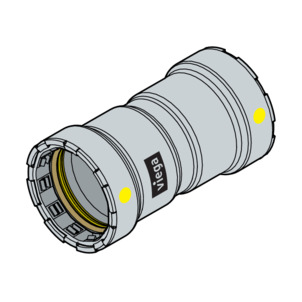
The Megapress G press connectors consist of non-alloy steel (material 1.0308) and have an external 3–5 µm zinc-nickel coating. There is a cutting ring, a separator ring and a profile sealing element in the bead of the press connector. The cutting ring cuts into the pipe during pressing and ensures a force-fit connection.
During installation, and later during the pressing, the separator ring protects the sealing element from damage from the cutting ring.
SC‑Contur
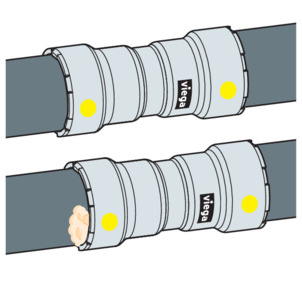
Viega press connectors are equipped with the SC‑Contur. The SC‑Contur is a safety technology that is certified by the DVGW and ensures that the press connector is guaranteed to be leaky in an unpressed state. In this way, inadvertently unpressed connections are noticed during a leakage test.
Viega guarantees that unpressed connections become visible during a leakage test:
with dry leakage test in the pressure range from 22 hPa–0.3 MPa (22 mbar–3.0 bar)
For leak detection, Viega recommends the specially developed Viega leak detection spray (model 5300). Leaks are immediately recognisable by the formation of bubbles.
Sealing elements
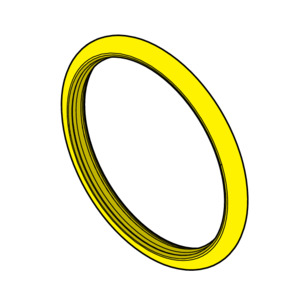
The Megapress G press connectors are factory-fitted with HNBR profile sealing elements. The integrally moulded sealing lips also seal pipe surfaces with slightly uneven surfaces.
Use |
|---|
Operating temperature |
Operating pressure |
Gas installation | Liquid gas installation | Heating oil and diesel pipelines | Compressed air (dry) |
|---|---|---|---|
-20 °C up to 70 °C | -20 °C up to 70 °C | ≤ 40 °C | ≤ 60 °C |
≤ 0.5 MPa (5 bar) (MOP 5) ≤ 0.5 MPa (5 bar) (HTR / GT5)1) | ≤ 0.5 MPa (5 bar) (MOP 5) ≤ 0.5 MPa (5 bar) (HTR / GT5)1) | ≤ 0.5 MPa (5 bar) | ≤ 1.6 MPa (16 bar) |
| 1) | Operating pressure at HTR requirement max. 0.5 MPa (5 bar) (GT5) |
Markings on components
Markings on press connectors
The press connectors are marked with a coloured dot. The dot identifies the SC‑Contur where the test medium would escape in the case of an inadvertently unpressed connection.

The press connectors are marked as follows:
Yellow point on every press connection
Viega
Yellow rectangle
Gas for gas supply lines
MOP5 for maximum operating pressure 0.5 MPa (5 bar)
GT/5 for operating pressure with HTR requirement maximum 0.5 MPa (5 bar)
HNBR for the factory-fitted HNBR sealing element
DVGW, SVGW
Dimension
Batch
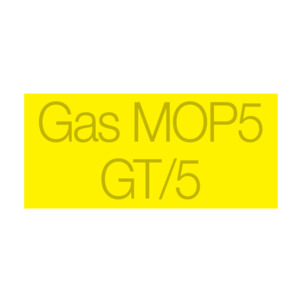
Information for use
Corrosion
Depending on the area of use, corrosion protection measures may have to be taken into account. One differentiates between external pipelines (underground and overground external pipelines), as well as internal pipelines.
The pertinent guidelines must be observed for corrosion protection, see Regulations from section: Corrosion .
Handling
Transport
Observe the following when transporting pipes:
Do not pull the pipes over the sill. The surface could be damaged.
Secure pipes during transportation. Pipes may become bent due to shifting.
Do not damage the protective caps on the pipe ends and do not remove them until immediately before mounting. Damaged pipe ends must not be pressed.

INFO!
In addition, observe the instructions provided by the pipe manufacturer.
Storage
For storage, comply with the requirements specified in the applicable regulations, see Regulations from section: Storage :
Store components in a clean and dry place.
Do not store the components directly on the floor.
Provide at least three points of support for the storage of pipes.
Where possible, store different sizes separately.
Store small sizes on top of larger sizes if separate storage is not possible.
Store pipes of different materials separately to prevent contact corrosion.

INFO!
In addition, observe the instructions provided by the pipe manufacturer.
Assembly information
Mounting instructions
Checking system components
System components may, in some cases, have become damaged through transportation and storage.
Only use original parts in perfect condition.
Damaged parts must be replaced. Do not attempt to repair them.
Store products in a clean and dry place.
Check the installation pipes for suitable surface properties and the min./max. external diameter.
Do not press on embossed pipe markings.
The system is intended for underground device connection pipelines for gas devices for use outside. Press connectors are not permitted in underground liquid gas pipelines.
For gas installations, observe the applicable regulations, see Regulations from section: Notes on mounting .

NOTICE!
Active and possibly passive protection measures are required to protect a gas installation from tampering by unauthorised persons, see Regulations from section: Notes on mounting .
Active protective measures (e. g. gas flow monitor) must always be taken.
Passive protective measures (e.g. gas safety plugs and caps) must be selected and employed depending on the installation.
The general rules of mounting for gas supply lines
The following conditions amongst others are valid when laying gas supply lines:
Lay gas supply lines with clearance from the installation body, concealed without hollow spaces, or in ventilated ducts or shafts.
Do not install gas supply lines with operating pressures > 100 hPa (100 mbar) concealed in the wall.
Arrange gas supply lines in such a way that condense water or water dripping from other pipes and components does not affect them.
Do not lay gas supply lines in screed.
Shut-off systems and detachable connections must be easily accessible.
Requirements on concealed installations:
Lay stress-free.
Apply corrosion protection.
Do not use any detachable connections (screw fittings).

INFO!
Continuous, connection-free gas supply lines may be laid in hollow spaces (pre-wall constructions) to be connected to a gas device or a gas socket.
Ventilation is not required.
Preparation of the pipes
As long as they are free from dirt, smooth, firm, even and undamaged, the following pipe surfaces are suitable for the production of press connections without further treatment:

NOTICE!
Always check the quality of the pipe surface on the complete pipe circumference. For permanently installed existing pipes, for example, Viega recommends the use of a mirror to be able to check the surface quality on the complete pipe circumference.
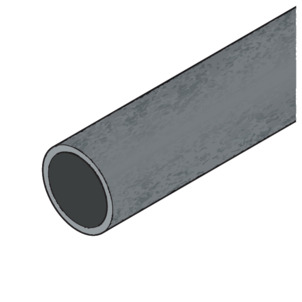
Black uncoated pipes
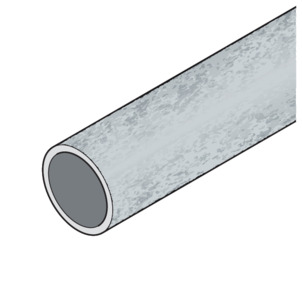
Galvanised pipes, for galvanisation see Standards and regulations (maximum external diameter in acc. with Pipes )
Pipe surfaces must be treated around the press connection if they exhibit the following characteristics:

Applied layers of paint (manual and industrial)
Exceeding the maximum external diameter due to coating that has been applied Pipes
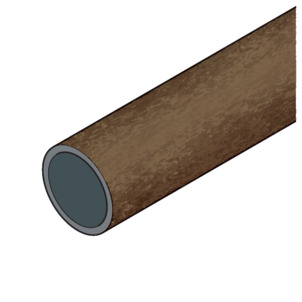
Bumps, damage, grooves, corrosion or loose adhesions
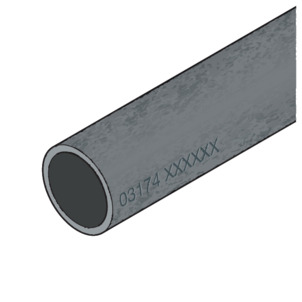

NOTICE!
Leaky press connection
Pressings on the embossed pipe marking may cause leaking.
Do not carry out pressings on the embossed pipe marking.
The following are examples of suitable tools for the work:
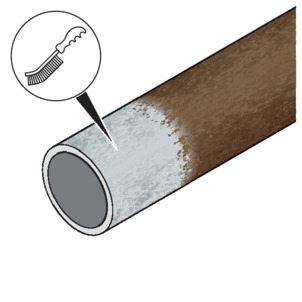
-
Wire brush
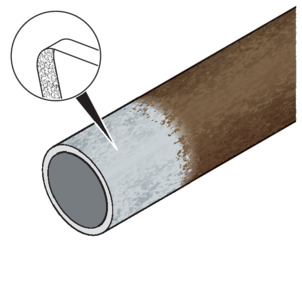
-
Cleaning fleece or sanding paper (grain > 80)
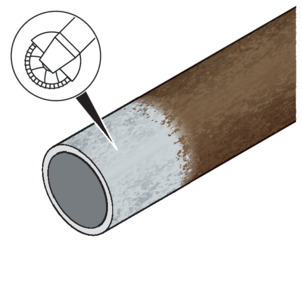
-
Angle grinder with serrated washer
After the treatment, the quality of the pipe surface should be as shown in the following graphic:

NOTICE!
Always check the quality of the pipe surface on the complete pipe circumference. For permanently installed existing pipes, for example, Viega recommends the use of a mirror to be able to check the surface quality on the complete pipe circumference.
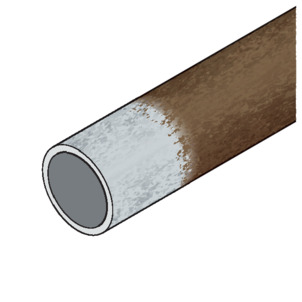
The external diameter of the installation pipe must not fall below the minimum value, see Pipes .
In systems where complete corrosion protection is required, those parts of the previously processed pipe surface that are uncovered after pressing must subsequently be equipped with suitable corrosion protection.
Potential equalisation

DANGER!
Danger due to electrical current
An electric shock can lead to burns and serious injury and even death.
Because all metallic piping systems conduct electricity, unintentional contact with a live part can lead to the whole piping system and components connected to it (e. g. radiators) becoming energised.
Only allow electrical work to be carried out by qualified electricians.
Always integrate the metal piping system into the potential equalisation.

INFO!
It is the fitter of the electrical system who is responsible for ensuring that the potential equalisation is tested and secured.
Space requirements and intervals
The minimum distance to welding seams and bending points must be 3 x D – however at least 100 mm.
Pressing between pipelines
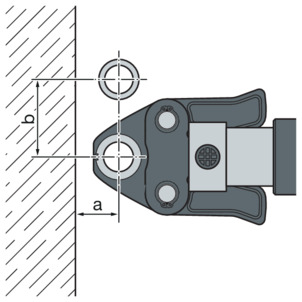
Space required Type 2 (PT2), PT3-EH, PT3-AH, Pressgun 4B, 4E, 5, 6, 6 B, 6 Plus
D |
|---|
a [mm] |
b [mm] |
½ | ¾ | 1 |
|---|---|---|
30 | 35 | 45 |
70 | 80 | 95 |
Space requirement Picco, Pressgun Picco, Pressgun Picco 6, Pressgun Picco 6 Plus
D |
|---|
a [mm] |
b [mm] |
½ | ¾ |
|---|---|
30 | 35 |
70 | 80 |

Space requirement press rings D½–2
D |
|---|
a [mm] |
b [mm] |
½ | ¾ | 1 | 1¼ | 1½ | 2 |
|---|---|---|---|---|---|
60 | 75 | 75 | 95 | 105 | 105 |
75 | 85 | 100 | 125 | 135 | 140 |
Pressing between pipe and wall
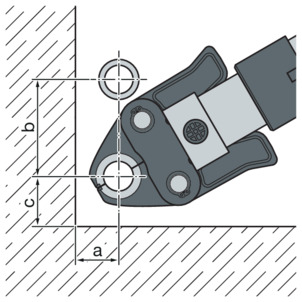
Space required PT1, Type 2 (PT2), PT3-EH, PT3-AH, Pressgun 4B, 4E, 5, 6, 6 B, 6 Plus
D |
|---|
a [mm] |
b [mm] |
c [mm] |
½ | ¾ | 1 |
|---|---|---|
35 | 40 | 50 |
80 | 90 | 105 |
50 | 55 | 65 |
Space requirement Picco, Pressgun Picco, Pressgun Picco 6, Pressgun Picco 6 Plus
D |
|---|
a [mm] |
b [mm] |
c [mm] |
½ | ¾ |
|---|---|
60 | 65 |
75 | 85 |
80 | 80 |

Space requirement press rings D½–2
D |
|---|
a [mm] |
b [mm] |
c [mm] |
½ | ¾ | 1 | 1¼ | 1½ | 2 |
|---|---|---|---|---|---|
60 | 75 | 75 | 95 | 105 | 105 |
75 | 85 | 100 | 125 | 135 | 140 |
80 | 80 | 80 | 80 | 80 | 80 |
Wall distance
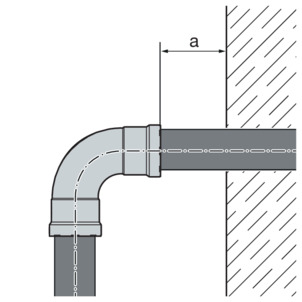
Minimum distance with press jaws D ½–1
Press machine |
|---|
Type 2 (PT2) |
Type PT3-EH |
Type PT3-AH |
Pressgun 4E / 4B |
Pressgun 5 |
Pressgun 6 /6 Plus |
Picco / Pressgun Picco |
Pressgun Picco 6 / Pressgun Picco 6 Plus |
amin [mm] |
|---|
50 |
50 |
Minimum distance with press rings D½–2
Press machine |
|---|
Type 2 (PT2) |
Type PT3-EH |
Type PT3-AH |
Pressgun 4E / 4B |
Pressgun 5 |
Pressgun 6 / 6 Plus |
Picco / Pressgun Picco |
Pressgun Picco 6 / Pressgun Picco 6 Plus |
amin [mm] |
|---|
20 |
20 |
Interval between the pressings

NOTICE!
Leaking press connections due to pipes being too short!
If two press connectors are to be mounted onto a pipe at a short distance apart,, the pipe must not be too short. If the pipe is not inserted up to the prescribed insertion depth in the press connector during pressing, the connection may become leaky.
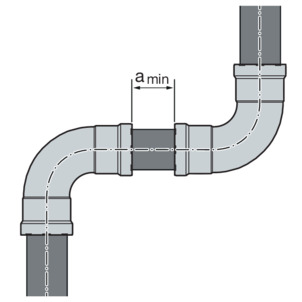
Minimum distance with press jaws D ½–1
D [inch] |
|---|
½ |
¾ |
1 |
amin [mm] |
|---|
5 |
Minimum distance with press rings D½–2
D [inch] |
|---|
½ |
¾ |
1 |
1¼ |
1½ |
2 |
amin [mm] |
|---|
15 |
Z dimensions
For the Z dimensions, refer to the respective product page in the online catalogue.
Required tools

NOTICE!
Megapress G press connectors may be pressed only with Megapress press rings and press jaws. Press rings and press jaws of the metal Viega press connector systems Profipress, Sanpress, Sanpress Inox and Prestabo cannot be used.
Possible combinations of press machines and press jaws
Press machines | Press jaws | Press rings | Set |
|---|---|---|---|
Type 2 (PT2) PT3 EH/AH Pressgun 4E / 4B Pressgun 5 Pressgun 6 / 6 B / 6 Plus | DN10 to DN25 model 4299.9 | DN15 model 4296.1, with hinged adapter jaw Z1 model 2296.2 | Press jaws DN15 to DN25, press rings DN32 to DN50, hinged adapter jaw Z2 model 4299.61 |
DN32 to DN50 model 4296.1, with hinged adapter jaw Z2 model 2296.2 | |||
Type 2 (PT2) PT3 EH Pressgun 4E / 4B Pressgun 5 Pressgun 6 Plus | — | DN65 to DN100 model 4296.1XL, with Pressgun Press Booster model 4296.4XL | Press ring DN65 and Pressgun Press Booster model 4296.2XL |
Press rings DN80 and DN100 model 4296.5XL | |||
Picco Pressgun Picco Pressgun Picco 6 / 6 Plus | DN10 and DN15 model 4284.9 | DN15 model 4296.1, with hinged adapter jaw P1 model 2496.1 | — |
The following tools are required for production of a press connection:
Pipe cutter or a fine-toothed hacksaw
Or angle-grinder
Or chopsaw with low cutting speed
Deburrer or half-round file and coloured pen for marking
Press machine with constant pressing force
Press jaw (D½–1) or press ring(D½– 2) with corresponding hinged adapter jaw, suitable for the pipe diameter and with suitable profile
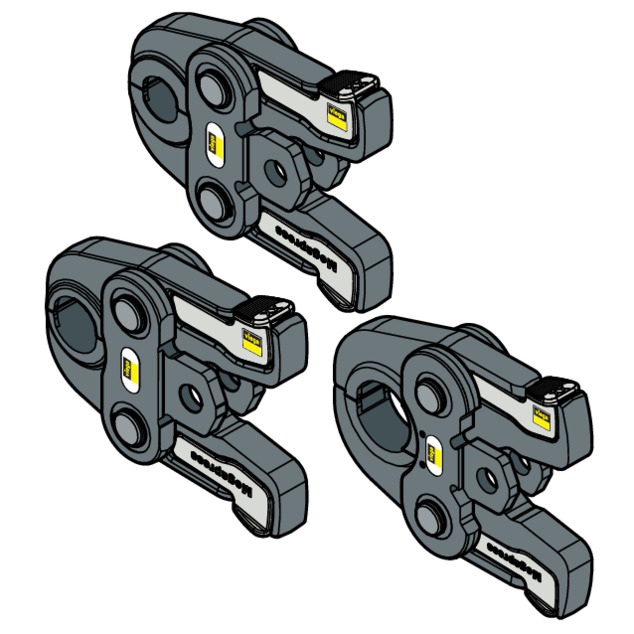
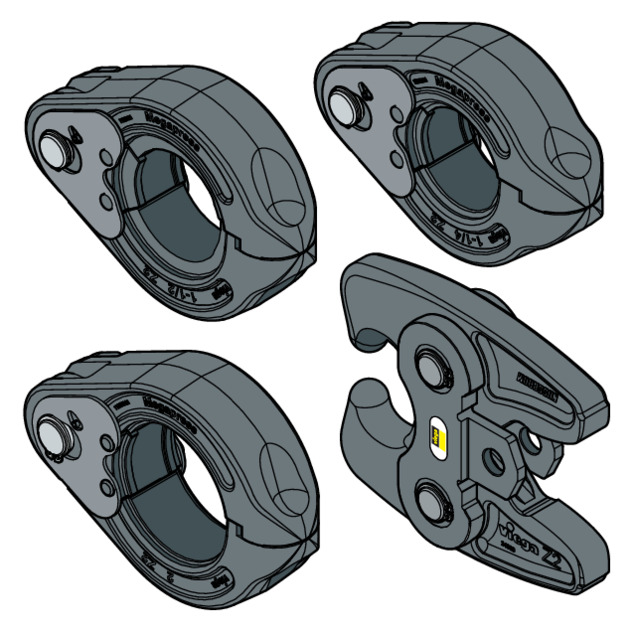

INFO!
Viega recommends the use of Viega system tools when installing the press fittings.
The Viega system press tools have been developed and tailored specifically for the installation of Viega press connector systems.
Assembly
Permitted exchange of sealing elements

NOTICE!
With their material-specific qualities, sealing elements in press connectors are adapted for use with the corresponding media and/or the areas of use of the piping systems and are generally only certified for them.
The exchange of a sealing element is generally permitted. The sealing element must be exchanged for a designated spare part for the intended application Sealing elements . The use of other sealing elements is not permitted.
If the profile sealing element in the press connector is obviously damaged, it should be exchanged for a Viega spare profile sealing element made of the same material.
Replacing the sealing element
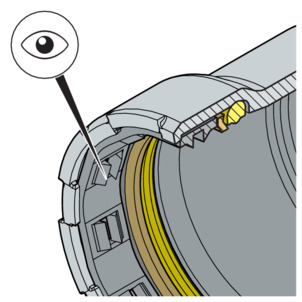

CAUTION!
Risk of injury due to sharp edges
There is a sharp-edged cutting ring above the sealing element (see arrow). There is a risk of injury (cutting) when replacing the sealing element.
Do not reach into the press connector with your bare hands.
Removing the sealing element

INFO!
Do not use pointed or sharp-edged objects to remove the sealing element. They may damage the sealing element or the bead.
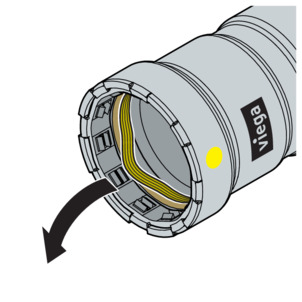
-
Remove the sealing element from the bead. Proceed carefully to avoid damaging the sealing element seat.
Inserting the sealing element
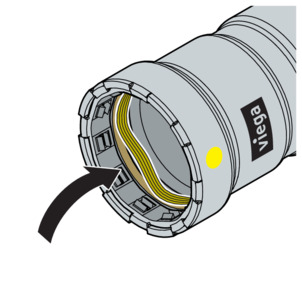
-
Insert a new, undamaged sealing element into the bead.
Make sure that the sealing element is not damaged by the cutting ring.
-
Ensure that the complete sealing element is in the bead.
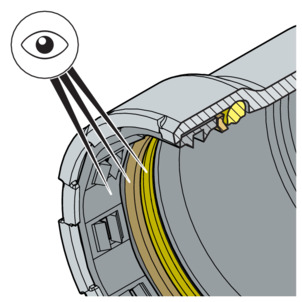
The correct sealing element is in the press connector.
HNBR = yellow
Sealing element, separator ring and cutting ring are undamaged.
The complete sealing element, separator ring and cutting ring are in the bead.
Cutting pipes to length

NOTICE!
Leaking press connections due to damaged material!
Press connections can become leaky due to damaged pipes or sealing elements.
Observe the following instructions to avoid damage to pipes and sealing elements:
Do not use flame cutters when cutting to length.
Do not use grease or oils (e. g. cutting oil).
For information about tools, also see Required tools .
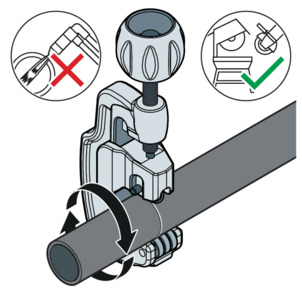
-
Cut the pipe at a right angle as accurately as possible using a pipe cutter, an angle grinder or a fine-toothed hacksaw to ensure a complete and even pipe insertion depth. Do not use a flame cutter.
Avoid grooves on the pipe surface.
Deburring the pipes
The pipe ends must be thoroughly deburred internally and externally after shortening.
Deburring prevents the sealing element being damaged or the that the press connector cants when mounted. Viega recommends using a deburrer.
≤ D1½ (model 2292.2)
D2 (model 2292.4XL)

NOTICE!
Damage due to the wrong tool!
Do not use sanding disks or similar tools when deburring. The pipes could be damaged by these.
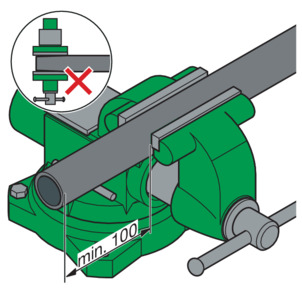
-
Secure the pipe in the vice.
-
When clamping, leave an interval of at least 100 mm (a) to the pipe end.
The pipe ends must not be bent or damaged.
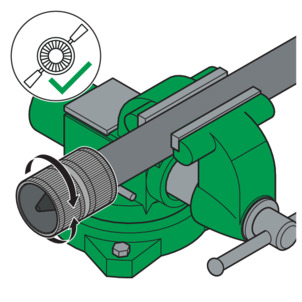
-
Deburr the inside and outside of the pipe.
Pressing the connection
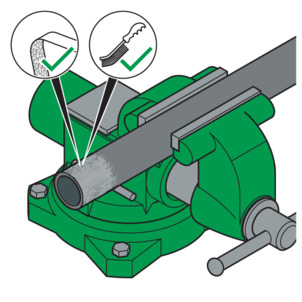
-
With the help of a wire brush, cleaning fleece or sanding paper, remove loose dirt and rust particles from the pressing area.

Requirements:
The pipe end is not bent or damaged.
The pipe is deburred.
The correct sealing element is in the press connector.
HNBR = yellow
Sealing element, separator ring and cutting ring are undamaged.
The complete sealing element, separator ring and cutting ring are in the bead.
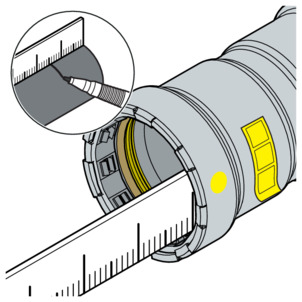
-
Measure and mark the insertion depth.
D [inch]
Insertion depth [mm]
½
27
¾
29
1
34
1¼
46
1½
48
2
50
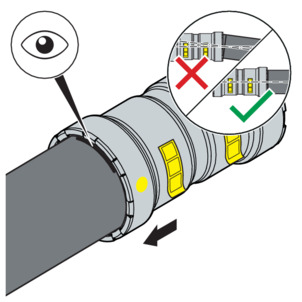
-
Push the press connector up to the marked insertion depth on the pipe. Do not twist the press connector.
Pressing with press jaw at D ≤ 1
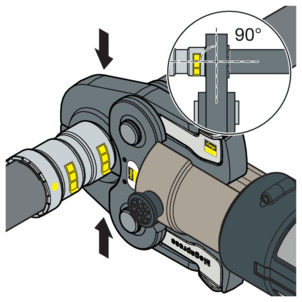
-
Insert the press jaw (≤ D 1) into the press machine and push the retaining bolt in as far as it will go.
NOTICE!Do not press the press connections under forced position or tension. If available, always mount the threaded, flanged or screwed connection firmly before the pressing process.
INFO!Observe the press tool instruction manual!
-
Open the press jaw and place it at a right-angle onto the press connector.
-
Check the insertion depth using the marking.
-
Ensure that the press jaw is placed centrally on the bead of the press connector.
-
Carry out the pressing process.
-
Open and remove the press jaw.
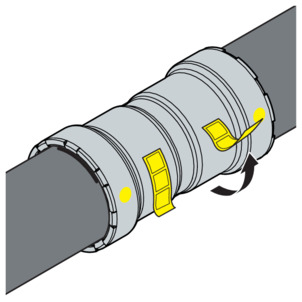
-
Remove the check label.
-
The connection is marked as having been pressed.
Pressing with press rings with D ⅜–2
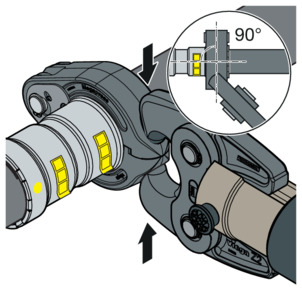
-
Place the hinged adapter jaw onto the press machine and push the retaining bolt in until it clicks into place.
NOTICE!Do not press the press connections under forced position or tension. If available, always mount the threaded, flanged or screwed connection firmly before the pressing process.
INFO!Observe the press tool instruction manual!
-
Place the press ring onto the press connector. The press ring must completely cover the outside ring of the press connector.
-
Position the hinged adapter jaw into the seat of the press ring.
-
Check the insertion depth using the marking.
-
Ensure that the press ring is placed centrally on the bead of the press connector.
-
Carry out the pressing process.
-
Open the hinged adapter jaw and remove the press ring.

-
Remove the check label.
-
The connection is marked as having been pressed.
Flange connections
In the press connector system shown, flange connections are possible in the dimensions 1¼ to 2 inches.
The assembly of flange connections may only be carried out by qualified personnel. Personnel can be qualified to assemble flange connections on the basis of applicable directives, for example; see Regulations from section: Establishing a flange connection .
A corresponding training section on proper flange connection assembly in vocational training (of staff/specialist personnel) with qualified completion as well as successful regular application are considered as sufficient proof.
Other employees without the appropriate technical training (e.g. operating personnel) who are to install flange connections must be provided with technical knowledge through training measures (theoretical and practical); this must be documented.
washers
The advantages of using hardened washers are:
Defined friction surface during assembly.
Defined unevenness in calculation and thus reduction of the scattering of the tightening torque, whereby a greater hexagon screw force can be achieved mathematically.
Flange types
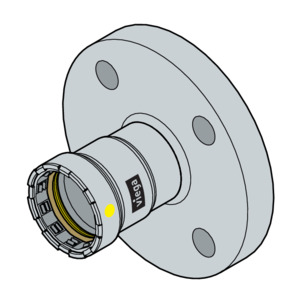
Fixed flange
Steel 1.0308 with an external galvanic zinc-nickel coating
Megapress G press connection
Model 4659.5: ½ to 2 inch
Establishing a flange connection

INFO!
Always make the flange connection first and then the press connection.
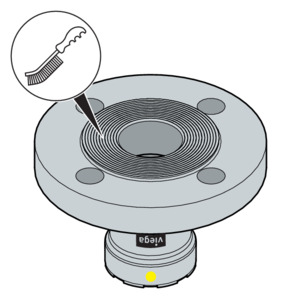
-
If necessary, remove any temporary coatings on the flange sealing surfaces without leaving any residue before assembly, using cleaning agents and a suitable wire brush.
NOTICE!When replacing seals, make sure to remove the old seal completely from the flange sealing surface without damaging the flange sealing surface.
-
Ensure that the flange sealing surfaces are clean, undamaged and even. In particular, there must not be any radial surface damage such as grooves or impact marks.
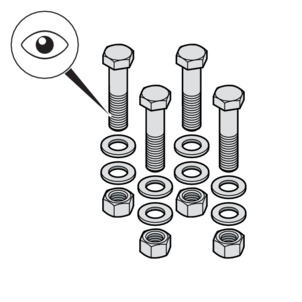
-
The hexagon screws, nuts and washers must be clean and undamaged and comply with the specifications for minimum hexagon screw length and strength class, see Required tightening torques .
-
The hexagon screw and nuts must be clean and undamaged.
INFO!Viega recommends using mounting set model 2259.7, consisting of hexagon screws, nuts and washers.
-
During disassembly, replace removed hexagon screws, nuts and washers with new ones if damaged.
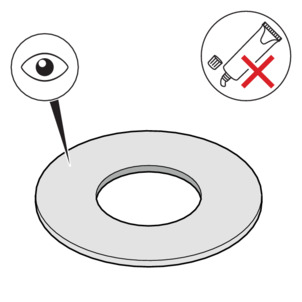
-
The seal must be clean, undamaged and dry. Do not use adhesives and assembly pastes for seals.
INFO!Viega recommends using the seal model 2259.9 from AFM 34/2.
-
Do not reuse used seals.
-
Do not use seals with kinks as they pose a safety risk.
-
Ensure that seals are free from faults and defects and that the manufacturer's specifications are complied with.
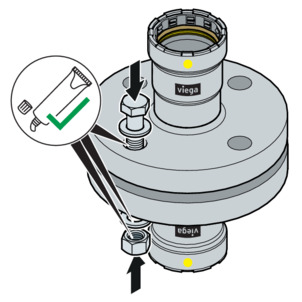
-
Lubricate the following flange elements with suitable lubricant:
Hexagon screw thread
Washer
Nut support
NOTICE!Observe the manufacturer's information on the application and temperature range of the lubricant.
Install and centre the sealing element
The correct assembly of flange connections requires parallel aligned flange blades without an offset centre that allow the sealing element to be inserted in the correct position without damage.
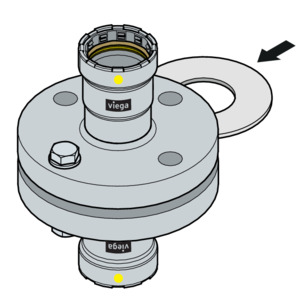
-
Press the sealing surfaces far enough apart so that the seal can be inserted without force and without damage.
The gap (out-of-parallelism of the sealing surfaces) before tightening the hexagon screws is not critical if the permissible gap is not exceeded.
DN | Permissible gap a-b [mm] |
|---|---|
15–25 | 0.4 |
32–50 | 0.6 |
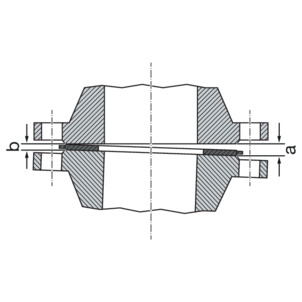
-
Remove the gap from the gaping side (a).
-
In case of doubt, tighten the flanges without inserting a seal by tightening the hexagon screws to achieve parallelism and a sealing surface distance of approx. 10 % of the nominal torque.
-
The gap is not permissible if the flange position cannot be achieved without great effort.
Systematics for tightening hexagon screws
The order in which the hexagon screws and nuts are tightened has a significant influence on the force distribution acting on the seal (surface pressure). Incorrect tightening leads to a high dispersion of the pretensioning forces and can result in the required minimum surface pressure not being reached and even in leaks.
After tightening the nut, at least two but no more than five threads should protrude from the end of the hexagon screw.
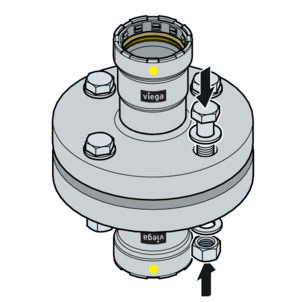
-
Prepare the hexagon screws by hand, observing the following:
Install the hexagon screws so that all the hexagon screw heads are on one flange side.
For horizontally arranged flanges, insert the hexagon screws from above.
Replace stiff hexagon screws with easy-running ones.
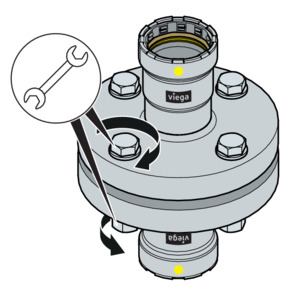
-
The simultaneous use of several tightening tools is possible.
Suit order
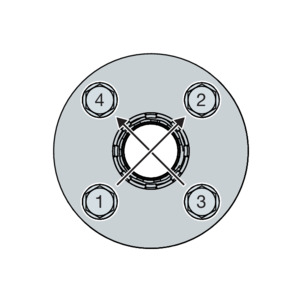
-
Tighten all hexagon screws crosswise with 30 % of the nominal tightening torque.
-
Tighten all hexagon screws as described in step 1 with 60 % of the nominal tightening torque.
-
Tighten all hexagon screws as described in step 1 with 100 % of the nominal tightening torque.
-
Tighten all hexagon screws again with the full nominal tightening torque. Repeat this process until the nuts can no longer be turned when the full tightening torque is applied.
Required tightening torques
Tightening torques Megapress G flange adapters
Model | DN | Article number | Thread | Min. req. tightening torque [Nm] | Max. perm. tightening torque [Nm] | Hexagon screw length [mm] | Strength class |
|---|---|---|---|---|---|---|---|
4659.5 | 15 | 740 0091 | M12 | 27 | 82 | 65 | 8.8 |
20 | 740 0161 | 41 | 82 | ||||
25 | 740 0231 | 54 | 82 | ||||
32 | 740 0302 | M16 | 78 | 202 | 70 | ||
40 | 740 0472 | 90 | 202 | ||||
50 | 740 0542 | 102 | 202 |
1
| For use with mounting set article number
494056
|
2
| For use with mounting set article number
494063
|
Disconnecting the flange adapter
Before starting to disassemble an existing flange connection, get approval and a work permit from the responsible company, if necessary, observing the following:
The system section must be depressurised and completely flushed.
Secure built-in or attached parts that are not held separately before loosening the flange connection. This also applies to fastening systems such as spring hangers and supports.
Start loosening hexagon screws or nuts on the side facing away from the body, loosen the remaining hexagon screws slightly and only disassemble completely when you have ensured that the piping system does not present a risk. If a pipeline is under tension, there is a risk of the pipeline rupturing.
Loosen the hexagon screws or nuts crosswise in at least two passes.
Close open ends of strands with dummy plugs.
Transport disassembled pipelines only in closed condition.
When replacing seals, make sure to remove the old seal completely from the flange sealing surface without damaging the flange sealing surface.
Leakage test
The installer must perform a leakage test before commissioning.
Carry out this test on a system that is finished but not covered.
Only carry out this test with suitable, tested and approved equipment.
Observe the applicable regulations, see Regulations from section: Leakage test .
Document the result.

NOTICE!
Multiple pressing or re-pressing of a leaking press connection is not permitted.
Maintenance
The gas installation must be given a visual inspection, e. g. by the owner, once a year.
Serviceability and leak tightness must be checked every twelve years by an installation contractor.
To be covered by the warranty and to ensure the safe operation of the gas installations, operate and maintain them as intended, see Standards and regulations .
Disposal
Separate the product and packaging materials (e. g. paper, metal, plastic or non-ferrous metals) and dispose of in accordance with valid national legal requirements.